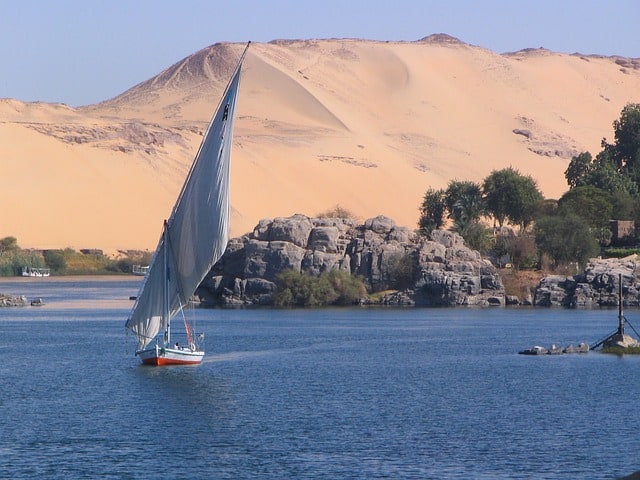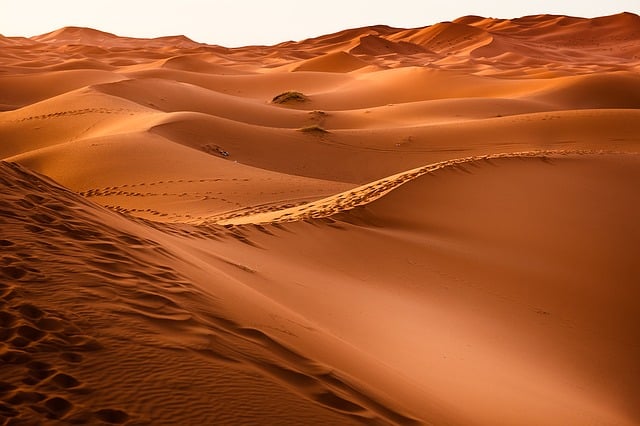30 Enchanting Facts About the River Nile That Will Stir Your Curiosity

The river Nile is one of the ancient rivers of the world. Since the time human civilization and habitation evolved, the mention of this river can be found. Although every river is relevant for the individuals and the wildlife habitat living in proximity, the Nile continues looming large because of its historic significance and cultural status. The river has various exciting features that make it one of the most abundant rivers in terms of silt deposition. Let’s find out 30 amazing facts about the Nile.
20+ Enchanting Facts About the River Nile
Fact 1. River Nile and Egypt
The river Nile has immense significance on the history and evolution of the Egyptian Civilization. It flows throughout the country and is the country’s major water source. Most of Egypt is a desert zone, and rainfall is not so dense here. The Nile seems one of the significant perennial sources which are helping various needs of the Egyptian people.
Indeed, the country wouldn’t have thrived if it weren’t for the resources provided by the Nile River. At that point, the majority of the Egyptians built homes in proximity to the river. They used the river water for drinking, preparing food, agriculture, and fishing.
Fact 2. The Longest River
The river Nile is known as the longest river in the world. It covers a distance of 6695 kilometers (4160 Miles). It stretches from Great Lakes of Africa, crosses the Sahara Desert, and finally flows into the beautiful Mediterranean Sea. It is worth noting that unlike any other river, the Nile passes through more than eleven countries, draining around 10% of the entire continent of Africa.
Given these striking characteristics, the Nile is deemed to be the longest river of the earth. While many scientists have voiced contentions about the size Nile and Amazon river, the Nile still stands out because of its highly elongated river channel. That being said, there are still several unpublished studies claiming the Amazon to have a longer body, but since these studies haven’t yet been published or verified, the claims are still not confirmed.
Fact 3. Location of the River Nile
Though this river has immense significance over the evolution of Egyptian civilization but, one should not be mistaken about its actual location. Before entering Egypt, the river covers nine different countries, and it finally ends into the northern edge of Egypt in the Mediterranean Sea.
Fact 4. The Starting Point
There are various theories regarding the starting location of this ancient river. One of the acceptable arguments suggests that the river starts its course from the area of Lake Victoria. Again, Lake Victoria has various feeder rivers that seem to merge in this location. The Kagera River is said to be the biggest feeder and is known as the real source of the river Nile.
Although several individuals claim the tributary to be emerging from Lake Victoria, scientists have questioned this and are still trying to find the source.
Fact 5. The Endpoint of the River Nile
After passing through nine different countries, which are Tanzania, Uganda, Burundi, Rwanda, Kenya, Zaire, Ethiopia, Sudan, and Egypt, the river merges into the Mediterranean Sea.
Fact 6. Two Major Tributaries
The river Nile has two major tributaries, which are the Blue Nile and the White Nile. But wait, you won’t be witnessing a blue color or a whitish version of the river. The names came from the amount of silt deposition made by the river.
Fact 7. The Blue Nile and the White Nile
The Blue Nile and the White Nile meet in Sudan to form the main Nile River. But the source of White Nile is not Lake Victoria but somewhere in between Rwanda, Ethiopia, and Burundi, the actual source of the river is established. Moreover, both the tributaries play an essential role in the perennial water supply, which reciprocates the constant flow of water throughout the year.
Fact 8. Origin of the Name “Nile”
The name ‘Nile’ has originated from the Greek word ‘neilos’ that refers to ‘valley.’ During the ancient Egyptian civilization, this river was referred to as ‘Ar’ or ‘Aur.’ These two words mean the same that is “black.”
Fact 9. Why did the Ancient Egyptians call it the Black River?
The Egyptian civilization developed mainly in the location which was created from the silt deposition of this ancient river Nile. Along its long course, the river brought silt which was formed from chunks of boulders, rocks and plant debris. This silt is known as one of the richest natural soil in the world. It is this mineral-rich feature of this river that got it referred to as the Black River.
Fact 10: Nile and the Papyrus
We already know the role of the Nile in fostering the agrarian economy of Egypt. But did you know the development of Papyrus is also credited to this river? Centuries back, tiny reeds grew along the riverbeds. Egyptians harnessed these reeds to create papyrus that served the purpose of the paper. At that point, papyrus was used for writing books and relaying messages. In some cases, they were also used for creating boats.
Fact 11: Lifeline of Egypt
The Nile is often touted to be the lifeline of Ancient Egypt. Indeed, the country wouldn’t have thrived if it weren’t for the resources provided by the Nile River. At that point, the majority of the Egyptians built homes in proximity to the river. They used the river water for drinking, preparing food, agriculture, and fishing.
Fact 12. The age of the River Nile
The existence of the river Nile can be found as early as 3000BC. From the archeological evidence, it has been established that the quality amount of farming was practiced along the banks of this river. Moreover, the entire ancient history of Egyptian civilization is associated with this great river.
Fact 13. Significance of the River Nile
The river Nile is the primary source of water supply not only in Egypt but also supports ten percent of Africa’s water supply. The Egyptian Civilization since the days of Pharaohs has been extensively using the river Nile for various practices that are essential for livelihood.
Fact 14. The Portion of Egypt Depending on the Nile
About eighty percentage of Egypt falls on the banks of this river, and the entire country is mostly dependent on this river for the annual water source as there is a shortage of rainfall in this geographical region.
The river brings very rich and fertile silt along with it. Since its path is very long, the portion it flows through Egypt gets the maximum silt deposition which formed the large delta on which the land of Egypt is situated.
Fact 15: The Iconic Nile Expedition
In a bid to ascertain the original length, explorers began the White Nile Expedition back in 2004. This navigation was first of its kind, where the total length of the river was assessed. Spanning across more than 134 days, the journey commenced from Uganda before finally ending in Rosetta.
Fact 16: The Delta Houses More than 50% of Egypt’s Population
You read that right! More than half of the population of Egypt lives in and around the Nile Delta. Located in Northern Egypt, this Delta is the draining spot of the Nile River. It stretches across 164 km (length) and 240 km (width). Rich in silt and nutrients, the Nile Delta is ideal for agriculture.
Fact 17: The Rosetta Stone
In 1787, the iconic Rosetta stone was discovered in the Nile Delta. This artifact has a major role in our modern assessment of Egyptian paintings and hieroglyphics.
Fact 18. Annual Flood Helping Farmers
The river Nile never gets dried up, and yearly floods are frequent in this river. From the early days to date, if you carefully look at the map, you can notice that the river has changed its actual course and shifted a bit. Every year during the flood, the river used to deposit fertile soil on the banks of Egypt.
When the water dried up, the Egyptians used this fertile land for cultivating crops. Yearly floods helped the civilization to yield high-quality crops with higher productions, and they could also use the river for transporting their products to other lands.
Fact 19. Aswan Dam on the River Nile
The river Nile, whose journey started around five million years ago, played a vital role in Egyptian history. Every year between June and September, this river flooded its bank. This occurrence was a yearly process, and the submerged land became more fertile each year. But on the other hand, Egypt faced the loss of lives and various damages due to this flood, which turned devastating at times.
The construction of the Aswan Dam on river Nile started in 1960, and it was by 1970s that the annual flood could be controlled. This helped use the natural source in household activities, and in one word, the water of Nile is the primary source of water supply even for modern day Egypt.
Fact 20: Hapi: The God of Flood
Ancient Egypt is beset with myths. According to sources, Egyptians worshipped God Hapi for bringing in the flood. He was honored and highly revered as floods led to excellent fertility that further facilitated the growth of vegetation in the area.
Fact 21. Helping Business Growth
The river Nile was one of the major trade routes which helped the Egyptians to take their products to the other parts the word. The paper we use today was first made from the leaves of papyrus, a leaf of a plant which is grown on the banks of this fertile river. The perennial water flow helped the merchants to bring goods through the waterway, which made transportation an easy process even in the medieval period.
Fact 22. Assisting in the Construction of Pyramids
Egypt is referred to as the land of great Pyramids. These ancient tombs were built on blocks and chuck of rocks. During the ancient civilization, from the size and height of the pyramid, the status of the King or Pharaoh was determined. Tons of rocks were required in the building process.
The river water was used as the means of transportation for accumulating and gathering the stones and blocks for the pyramids. Even the regular water requirement for the pyramid worker was met with the water of this ancient river.
Fact 23. Flora Along the River Nile
A wide variety of vegetations makes the destination an ideal tropical rainforest area that is mostly covered with thick forest patches. Trees like rubber, bamboo, banana, coffee shrub and ebony with patches of mixed woodland and savanna are present here. There is also a grass ground cover with perennial thorny trees and mixed shrubs.
Fact 24. Vegetation in Rainy Season
During the rainy season, the land becomes very swampy, making it a desirable location for the growth of tall grasses similar to bamboo. The river has a range of tropical rainforests that are lined with banana trees, bamboos, ebonies, and tiny shrubs. These species are known as papyrus. South American water hyacinths are witnessed, especially where there is less current on the water surface.
Fact 25. Living Creatures Along the river Nile
Crocodiles, Hippos, buffaloes, and antelopes are familiar creatures that are found in this area. The crocodiles which are found in the Nile basin are recorded as the world’s largest species that can gallop half the weight of its body in one sitting. Among other animal species, you will find soft-shelled turtles, a range of snakes like cobras and mambas, lizards, and the iconic Nile crocodile.
Fact 26: Crocodiles Are Worshipped
You’re probably afraid of vicious crocodiles, but the people living near the Nile do not think the same way. Popularly known as Nile Crocodiles, these species abundantly thrive in the city of Faiyum (formerly known as Shedet).
Located in Cairo, inhabitants of this city deeply revered the crocodile deeming to be god’s worldly manifestation. Live crocodiles, locally called the ‘Petsuchos’ are studded with jewelry and worshipped in temples. Upon dying, they are replaced with a crocodile of similar species.
Fact 27: Multiple Languages
Given the length of the Nile, it traverses through diverse areas inhabited by indigenous people. Contrary to the common notion, these tribes have different languages. The population near Lake Victoria speak Bantu, the inhabitants near Sahara speak Arabic and the people of South Sudan speak Nilotic.
Fact 28. The Nile and Present Egypt
The river Nile is still an essential part of modern Egypt. Major transport routes are developed via the river, and the portion of the river bank outside the city is still used as a land for farmers. Irrigation and water demand of the country is primarily met by this river.
Fact 29: A Symbol of Afterlife
According to Egyptian myths, Osiris, an Egyptian God was tricked and killed by his brother Set. After killing him, Set chopped his body parts and flung them into the Nile. When Osiris’ wife searched for her deceased husband, she couldn’t find all his body parts.
Since he wasn’t reincarnated, he is believed to have become the god of death and the underworld. Due to Osiris’ links with the river Nile, the river is often considered to be a symbol of the afterlife. While its eastern area represents life, the western part is said to symbolize death.
Fact 30. A Tourist Attraction
The Nile is a favorite tourist destination for people visiting Egypt. Various cruises provide different attractive deals on river tours.
In a nutshell, without the presence of the river Nile, the Egyptian Civilization couldn’t have evolved. And, in the present-day also, the Nile remains an integral part of Egypt and its people.
Sources:
http://justfunfacts.com/interesting-facts-about-river-nile/
https://www.britannica.com/place/Nile-River/Plant-and-animal-life







